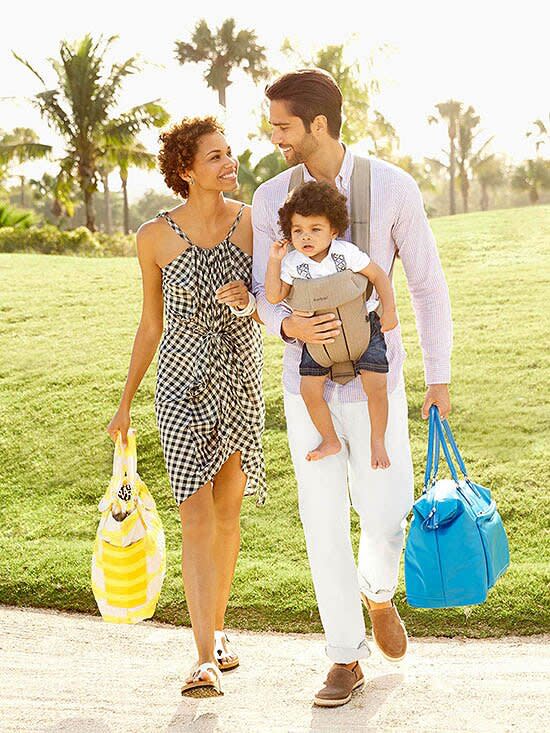Baby's First Plane Trip

Thayer Allison Gowdy
1. Time it right
When booking a flight, "think about what you would be doing with your baby at that time at home," notes Brianna Meighan, author of How to Fly With a Baby. "If your flight will be boarding at the exact time you would normally feed your baby, give him his meal a few minutes before getting on the plane," Meighan says. "If you are behind schedule, that's when you will start to see the meltdowns." Consider his personality too. "If he usually falls asleep when you're out running errands, it may not matter what time he flies," says Jennifer Shu, M.D., pediatrician and coauthor of Heading Home With Your Newborn. "But if any little disruption sets him off, book late evening when he is more likely to sleep through the trip."
2. Please be seated
Sitting in the front of coach might cost a bit more, but it can make shuffling on and off with Baby less of a pain, Meighan says. If you use a car seat, it must be installed in a window seat to avoid blocking passengers, and some airlines don't allow them near exit rows or in first class.
3. Take the safe route
Though many airlines allow children younger than 2 to fly in an adult's lap for free or at minimal cost, Dr. Shu and most safety experts advise purchasing a separate seat and bringing an FAA-approved car safety seat. Seats that meet FAA standards will carry the stamp, "This restraint is certified for use in motor vehicles and aircraft." If yours does not, you will be asked to check it. And even if your car seat is FAA-approved, you should measure it before your trip and confirm with your airline that it will fit.
4. Pack smart
Fill your carry-on tote with essentials, including extra diapers, wipes, and a change of clothes (for Baby and you). Also bring a rolling trolley bag for the overhead bin. Use this bag to hold backups of everything already stowed in your checked luggage—you'll be glad for them if you have a delay. Formula and breast milk aren't held to TSA limits on liquids, but it's still wise to secure them in plastic bags for easy inspection and to prevent messy leaks. As for entertainment, just take two or three simple toys and board books, Meighan says. Forget toys that have multiple pieces or make sounds.
5. Get through security
Many airports offer a special security line for families, so you don't have to feel as rushed. Roll up with Baby in a lightweight stroller. Once you reach security, take her out and hold her. As the agents examine your stroller and other items, you can walk through the scanner with Baby. When you're done, plop her back in the stroller and then check your stroller at the gate before boarding.
6. Don't sweat ear pain
Though many moms worry that Baby will experience ear issues, most infants have no problems at all, Dr. Shu says. The exception: If your child currently has a cold or ear infection. Air pressure is equalized by the eustachian tube, the passageway leading from the middle ear to the back of the throat, but inflammation and mucus can throw things off balance. If this happens to your baby while in the air, have him suck on a pacifier, bottle, or breast to help open up his passages, Dr. Shu advises. Be sure to check with your physician before flying if your baby is ill.
7. Have a feeding plan
When it comes to nursing, a shawl or blanket can help keep things discrete. With formula, Dr. Shu suggests, you should prep before you leave home. Measure servings of powdered formula inside a few bottles. Once on board, all you'll have to do is take them from your carry-on and add water. If your tot is old enough to eat solids, pack baby-food pouches for neater meals, Meighan recommends.
8. Diaper deftly
Most airlines should have at least one lavatory with a changing table. Just take your changing pad along with you. No designated spot? No problem! Change him in your lap, says Meighan. Sit down on the closed toilet seat. Lay your baby on your lap facing you, and swap the old diaper for a new one. Or, if he's old enough to stand on his own, use one hand to hold him upright in front of you and the other to wipe and change.
Originally published in American Baby magazine in July 2014.
All content on this Web site, including medical opinion and any other health-related information, is for informational purposes only and should not be considered to be a specific diagnosis or treatment plan for any individual situation. Use of this site and the information contained herein does not create a doctor-patient relationship. Always seek the direct advice of your own doctor in connection with any questions or issues you may have regarding your own health or the health of others.
